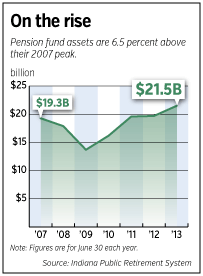Subscriber Benefit
As a subscriber you can listen to articles at work, in the car, or while you work out. Subscribe NowWith more money in bonds than in publicly traded stocks, Indiana’s $27.1 billion pension fund took a beating in the Bernanke sell-off and closed the fiscal year short of its targeted return.
The Indiana Public Retirement System earned 5.98 percent in the year ended June 30, but needed to hit 6.75 percent to cover its obligations to beneficiaries. Employers will have to make up the difference with larger contributions.
 Russo
RussoNoting that the return through March 31 had been 8 percent, Executive Director Steve Russo blamed the year-end result on market reaction to Federal Reserve Chairman Ben Bernanke’s comments about winding down the Fed’s bond-buying program, which has kept interest rates near historic lows.
The miss is no reason to shift INPRS out of bonds, which account for 31 percent of investments, Chief Investment Officer David Cooper said.
“There will be short periods of time during which diversification does not outperform, but a well-diversified portfolio should perform over the long term,” he said.
The performance was much better than last year, when INPRS earned 0.7 percent, and fund levels have recovered beyond their prior peak in 2007. Total assets in defined-benefit pension funds were $21.5 billion, 6.5 percent higher than the 2007 peak.
Indiana’s funds might yet rebound, but the year-end result exposed the down side of a new asset-allocation strategy that places a higher priority on reducing volatility than on maximizing returns.
Indiana seems to have followed the institutional-investor herd, so it’s no surprise that INPRS got burned by spiking interest rates in the wake of Bernanke’s comments, said Ken Skarbeck, principal of the Indianapolis money management firm Aldebaran Capital.
“Two years ago, stocks were very cheap, and yet every allocation plan on the planet had them selling stocks and buying bonds and commodities,” Skarbeck said.
Indiana’s largest bond class earned 0.5 percent, versus 4.5 percent over the most recent three-year period. A smaller category, inflation-linked bonds, lost close to 3.6 percent.
Indiana has 24 percent of its money in stocks, which returned 18 percent.
By contrast, the $262 billion California Public Employees Retirement System, CALPERS, has 52 percent of its portfolio in stocks and earned 12.5 percent through June 30.
INPRS also has money in alternative asset classes. Those include private equity, real estate, hedge funds and, under a strategy adopted in 2011, a category called “risk parity.”
 Risk parity managers spread money over stocks, bonds and commodities to reduce volatility, but they may use borrowing in an effort to hit the targeted return rate. The risk parity class saw its first full year of performance in March. At 9.6 percent of the INPRS portfolio, risk parity lost 0.4 percent through June 30.
Risk parity managers spread money over stocks, bonds and commodities to reduce volatility, but they may use borrowing in an effort to hit the targeted return rate. The risk parity class saw its first full year of performance in March. At 9.6 percent of the INPRS portfolio, risk parity lost 0.4 percent through June 30.
Borrowing against bonds—thereby magnifying the losses—is what hurt risk parity’s performance, said Greg Hahn, a former member of the INPRS board of trustees and principal at Winthrop Capital Management in Indianapolis
Hahn, who favored adding the new category, doesn’t think INPRS should back off. If interest rates had risen because of a much-improved economy, rather than in reaction to news about the Fed’s stimulus program, risk parity would have seen a positive return, he said.
“It’s a fundamentals-based strategy,” Hahn said.
Hahn also sees no reason to flee bonds or other asset classes. Bonds are still the best way to diversify the investment portfolio, he said, and he thinks the worst is in the past.
Cooper said he also is unconcerned about the rising interest-rate environment. The impact on bonds and other assets will depend on the reason for rising rates, the magnitude and speed of increases, as well as what the markets have already accounted for in valuations, he said.
“INPRS has developed an asset allocation to maintain diversification across and within asset classes to insulate the plan from the performance of one specific asset class,” he said.
Indiana has one of the most conservative pension systems in the country. Last year, INPRS became the first to adopt an assumed rate of return below 7 percent. Although pension funds aren’t posting long-term returns near 7 percent, many continue to assume a higher rate in order to keep employers’ required contributions minimal. In the long run, the pension plans run the risk of dipping into their principal to pay beneficiaries.
Presenting annual results to the legislative Pension Management Oversight Committee in late August, Russo said INPRS is focused on reducing volatility for the benefit of employers who pay into the system. Huge performance swings make planning contributions difficult, he said.
Cooper said INPRS is not likely to make any changes based on a one-year return.
“That’s the culture of the organization,” Hahn added. “Let’s not get over our skis on the risk curve to hit that target.”•
Please enable JavaScript to view this content.
